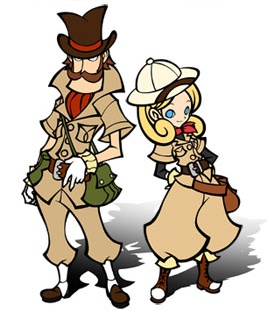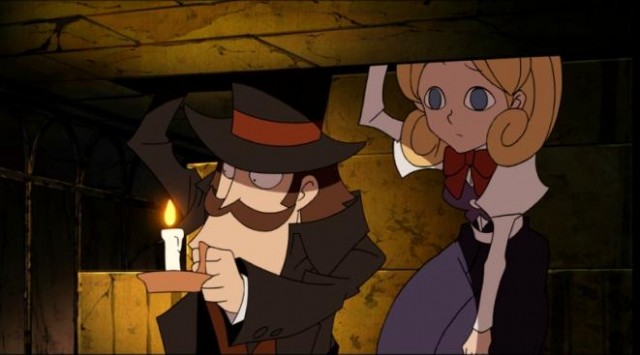Detailed Parisian overworld, clever story concepts, vast amount of French history
Monotonous and broken game design, unlikable and annoying hero, inconsistent visual presentation, extremely slow pace
Perhaps the greatest buzz accompanying the release of Konami’s and Winkysoft’s Doctor Lautrec and the Forgotten Knights late last year was its acute, superficial similarities to Level 5’s Professor Layton series: a leading man always seen with a top hat wrapped in an orange ribbon and who lectures on archeology, a plucky younger sidekick, European settings and artistic leanings and, most importantly, a reliance upon brain teaser-styled puzzles. Actually playing the game, even more similarities surface, from the accordion-tinged soundtrack (the game is set in 1888 Paris, after all), an exaggerated, comic relief rival who’s not the real villain, an inadequate police force headed by a cranky sergeant who’s always one step behind, and a supernaturally-enhanced set of true antagonists who are both frightening and sympathetic.
Yet reverent homage or not, Konami’s well-timed attempt to capitalize on the lack of a true Professor Layton game in 3DS’s library falls short, due to monotonous and poorly explained gameplay, inconsistent artistic presentation and a truly unlikable main character. There’s no question, Layton aping aside, that heart was put into the game: there’s plenty of high quality voice acting, exhaustive historical research and text on nearly every street and landmark in Paris, and even an attempt at some very “un-Laytonly” gameplay elements. Yet those elements don’t make up for the flaws.
Doctor Lautrec and his world are already in action when the game begins. Professionally, he’s a museum lecturer with a questionably obsessed assistant/teacher’s aid named Sophie. Yet on the side, the professor and his sidekick’s real adventures occur chasing down treasures through underground catacombs that exist below every block in Paris. A mysterious masked woman who runs a bar under the Paris opera house inexplicably has dozens of treasure maps for these catacombs, and she sells these maps to Lautrec and many other treasure-seeking adventurers eager to pilfer riches left over from Louis XIV’s time.
Yet Lautrec isn’t interested in gold or gemstones: he blatantly sneers at them once he reaches the treasure room. Instead, his true passion is for “treasure animatus,” or “living treasure” as it’s more colloquially described. These trinkets, which are often ancient household items like vases and plates, are actually possessed by hostile, elemental spirits that can tamed if beaten down to a fifth of their life bar during in-game battles. These Pokémon- and card battle-inspired sequences are certainly the most shocking and unique element if you’re expecting a mere Layton rip-off, and for as much as they could differentiate and boost the game’s experience, their blink-and-you’ll-miss-it tutorial is so incomplete and poor, you’ll easily spend a dozen hours in the game and still not know the ins and outs of the battle dynamics.
Yes, your tamed treasure animatus has a certain amount of hit points, a certain attack strength and hierarchical strengths and weaknesses to animatus of other elemental origins. You know that the wild animatus you’re trying to tame is always in the center of a pair of concentric cirlces, and lining these circles are a number of pedestals you place your own tamed treasure upon to attack the wild animatus. Yet how does an unblemished, slightly cracked or massively cracked treasure pedestal affect your treasure’s attack and defense? Some pedestals are linked together for a reason, but why is that? Does that have something to do with the unexplained “synergy” screen in your inventory that may never list any info throughout an entire play-through?

As you fumble through battles with random boosts and weaknesses affecting your carefully selected inventory of treasures (you can only enter a dungeon with three, but any gathered along the way can also be used before finishing a dungeon), frustration and apathy will set in. Battles are a mix of chance and the developer flippantly disregarding whether the gamer knows what on Earth is going on. As the difficulty of battles steeply ramps up in later catacombs, the lack of documentation or support, regardless of endless allowed do-overs, is nearly inexcusable. You can infer a greater knowledge of the battle system would make for a richer, deeper and conquerable experience, but in the one part of the game that has any semblance of depth or challenge, you’re discouraged, if not prevented, from knowing all its intricacies.
Yet just as unsavory is the unrelenting grind preceding every such battle. As mentioned before, Lautrec and Sophie acquire a “map” which is usually a mysterious illustration and a cryptic phrase about French icons and/or history. Lautrec and Sophie debate what the riddle could mean and identify streets or landmarks on the extensive Parisian overworld map for you to run to, the first set of which are always red herrings that you must go to whether interested or not. Once at these teaser locations, either another dialogue between Lautrec and Sophie or Sophie interrogating people on the street for ideas ensues. This leads to another set of locations being plotted, one of which is the correct destination, which you’ll either intuit or more likely discover via trial-and-error visits. In all, though, the player is just button mashing through screen after screen of text (this is the one area that’s not voice acted) and having little to no interaction or impact on how the two figure out the more elegantly designed “puzzles’ of the game– the puzzles of words and metaphors that allude, Da Vinci Code-style, to landmarks and street names.
Once at the target destination, Lautrec stands at a fixed point and scans the area in first person view for a fleur de lis symbol, which identifies the entrance to the treasure’s underground dungeon. Sophie confirms if your equipped treasure animatus should be strong enough to best the dungeon’s wild animatus, and away you go into a series of multi-level dungeons composed of nearly identical rooms. The dungeon rooms are patrolled by inept guards who, if they see you sneaking around, will drop you back at the entrance of the current room, but you can actually walk in front of or just to the side of them and remarkably be ignored. Avoiding booby traps and solving increasingly complex crate-pushing platforming puzzles are the next challenge.
Yes, the stealth action and crate-pushing are other departures from Layton and are just as poorly implemented. While the stealth portions and booby traps are usually quick enough to deal with, the crate-pushing puzzles are extensive and, later in the game, incredibly complex and time consuming. Aggravating the fact that this 1990s gameplay chestnut appears so often is that Lautrec is incredibly slow in pushing boxes, and he can only push them, not pull them. His constraints in box maneuvering obviously add a layer of complexity and tension when dealing with slowly patrolling guards (who will reset your 15 minutes’ worth of box pushing if they see you) but given the shallow puzzles and monster taming they lead to, maintaining interest and enthusiasm is almost masochistic.
The dungeons’ puzzles are being mentioned last since they may have seemed the most derivative aspect of Layton-baiting Doctor Lautrec has to offer. There’s nothing wrong with Doctor Lautrec having brain teaser puzzles, though. The problem lies in their monotonous execution. Yes, there are apparently 250 puzzles, but all of them fall into one of five different variations, devoid of variety or even a color scheme that varies from “sepia tone.” Drop French words into a crossword puzzle diagram. Find the one to four differences in a pair of French paintings. Identify the next arrangement of symbols in a sequence of patterns. Fit Tetris-styled blocks into pre-existing shapes. Play a Windows Minesweeper clone. Repeat ad nauseum.

What’s that? A seemingly Don Paolo-esque moustache on a Layton-lookalike? We won’t be fooled so easily this time!
The puzzles are almost always ridiculously simple, aside from the occasional Minesweeper or Tetris-block puzzle, and they’re so repetitive in execution and presentation that there’s no wonder or variety to them as often happens with the Layton games’ puzzles. And since these puzzles must be solved to progress to the treasures, they feel more like mundane busy work the more they’re encountered.
The last item that could make up for all of these shortcomings is the story and presentation, and there are some inspired moments. The overarching storyline, which pulls in references ranging from The Man in the Iron Mask to The Phantom of the Opera, as well as secret descendants of French royalty, is certainly intriguing. Plus, the amount of text and dialogue poring over France’s and Paris’s history could likely double as a history class if not curious travelogue. The soundtrack, while not extensive, has some appealing tunes and instrumental choices, and the unexpectedly significant amount of voice acting is well-performed.
Visually, the game’s hit or miss, largely due to its inconsistent visual presentation. The game’s characters are presented in three ways: as thickly-outlined, Warioware-esque cartoon portraits during most dialogue sequences, as hand-drawn cartoons during a few animated cut scenes, and also as blocky, Nintendo 64-era three dimensional character models for the larger portion of the game’s cut scenes and dungeon-crawling. The game’s interiors and maps are similarly disjointed– either attractive hand-painted stills or chunky three dimensional renderings. Why there’s so much variation in presentation is uncertain, but it’s jarringly inconsistent.
Yet the heart of the game’s story and cast is Doctor Lautrec, and he’s completely arrogant and patronizing to those around him. Because of his intelligence, he’s respected, adored and flirted with to no end by secondary characters, which is mystifying since there’s genuinely nothing endearing about this socially inept jerk. His condescending attitude and inability to establish emotional relationships emphasize that he only interacts with those who can serve his personal interests of greedily acquiring as many treasure animatus as possible. After all, the primary reason he keeps Sophie around is because she’s one of the few who can actually see the spirits that possess treasure animatus: surprise, Lautrec cannot. So Sophie’s presence during treasure hunting is necessary only for identifying the elemental essence of a spirit. Strangely, Lautrec shares more in common with Nintendo’s Wario than Level 5’s Layton, but with none of the oddball charm Wario musters, resulting in another unappealing distinction.
Doctor Lautrec and the Forgotten Knights is a collection of missed opportunities. It’s a game that wants to be like a Layton game and not be like one, and suffers in the comparison because of all the ways it falls short. The incredible amount of French history, clever story elements and extensive dialogue filling the game establish this wasn’t a title that was thrown on shelves with minimal investment. Yet all the best intentions cannot make up for poorly executed gameplay and an unlikable hero.




 ShareThis
ShareThis







Thick-outlined character design looks like something from the Puyo Puyo games (check out Puyo Pop Fever).
Still, it’s a shame how this ended up being.
Thank you for the review.
THAT’s what the art reminded me of! I’ve always liked the Puyo Pop Fever art. So bright, so vivid. And wacky. Which I guess is not the impression Lautrec wants to give.